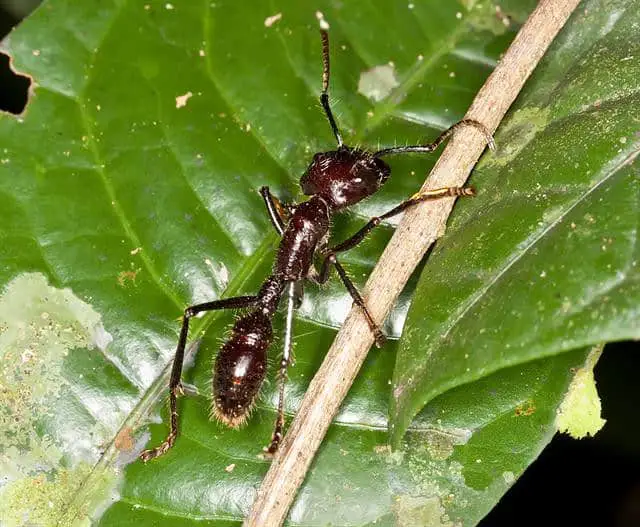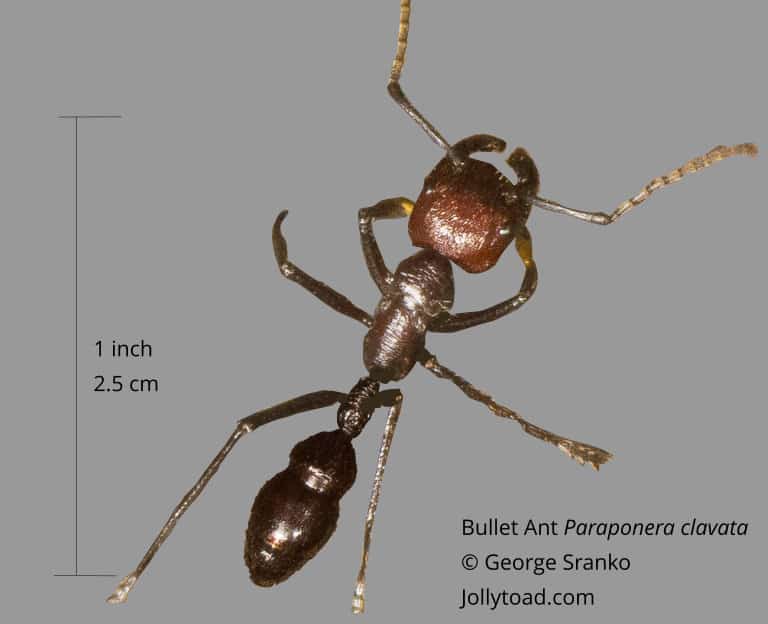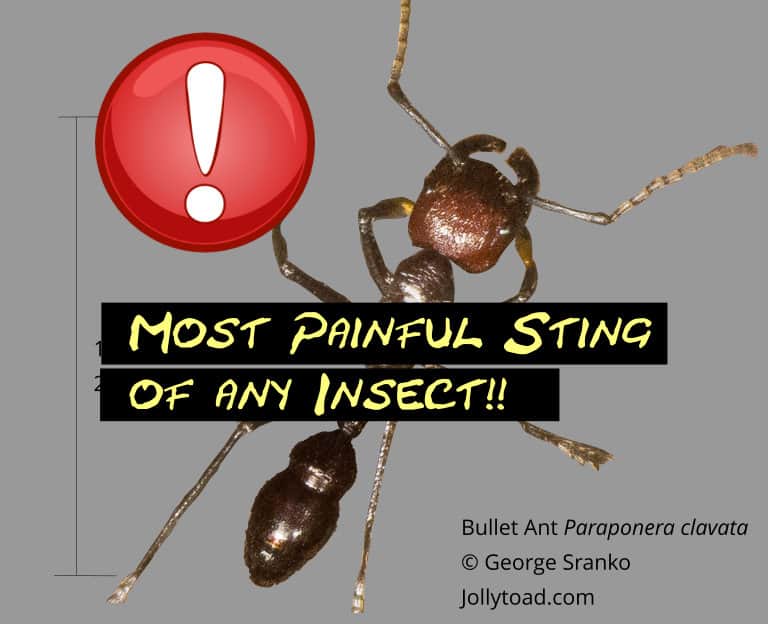I’ve always wanted to see a live bullet ant up close because of its reputation for having the most painful sting of any insect. My opportunity occurred in Ecuador, while hiking with a guide through the Amazon rainforest. Turned out the ants had us surrounded!
If you encounter a bullet ant, be extremely careful not to disturb it in any way. Bullet ants are not out to attack you but will become aggressive if provoked. They have the most painful sting of any insect. The biggest danger is to accidentally step or lean on one as you explore the rainforest.
Bullet ants, Paraponera clavata, are the largest ants, up to 1 in or 2.5 cm, and the sting is notoriously painful. The name comes from the fact that a sting from this ant feels like taking a bullet (thankfully I’m not speaking from personal experience!). The bullet ant’s sting is the most painful of any insect and the pain can last for 24 hours.

Interesting fact: Ants are the most abundant animals in the rain forest, and their total “biomass” would weigh more than any other group of animals found there.
Where can you find bullet ants?
Bullet ants are widespread throughout the tropical rainforests of Central and South America, including Honduras, Nicaragua, Costa Rica, Venezuela, Colombia, Ecuador, Peru, Bolivia, and Brazil. The ants build colonies in the soil and forage for insects and arthropods throughout the canopy. Each colony contains several hundred ants.

When we mentioned bullet ants to our guide Louis, wondering if it was possible to see one, he basically turned to a nearby vine and showed us a bunch of them. He told us they were common in the rainforest and I was surprised to see these huge ants were all around us, once we knew what to look for! They were busy going about their daily lives, ignoring us as they traveled up and down tree trunks and vines in search of food. They are one of the largest ants in the world and not that difficult to spot once you know what you’re looking for.
Bullet ants won’t sting unless provoked
Unlike some stinging insects that will attack just because you happen to be in the vicinity, bullet ants are not aggressive unless provoked. Nice to know that their sting is strictly defensive!

Our guide had fun poking the ants with a stick and then waving them towards us, while reminding us that the sting would feel like being hit by a bullet. We backed away so quickly that we could have bumped up against a vine covered in bullet ants!
Here’s a video showing a bullet ant calmly walking along a man’s arm without stinging him. OK, the man was pretty nervous!
The biggest danger with bullet ants
Our guide Luis showed us how easy it would be to inadvertently place your hand on a bullet ant while hiking through the rainforest. In our explorations we would often come across a tree down across the path or a steep slippery bank we had to navigate. Naturally, we would grab onto a vine or branch or small tree for support. They might simply be vines and branches for us, but for bullet ants they are busy highways and byways with potentially a lot of ant traffic!
This was an important lesson and one that has stuck with us.
In a tropical rainforest, never put your hand on a vine or tree – basically any vegetation – without checking to see if there’s some creature living there and whether the plant is safe to touch! There’s always a good possibility of finding biting or stinging insects, thorns, razor sharp leaves, toxic sap, or some other painful surprise!
In the Amazon, there’s a good chance you would get stung by a bullet ant if you inadvertently put your hand on one. Fortunately, we didn’t have to learn this lesson the hard way!
Is it a sting or a bite and why is it so painful?
If you look closely at a bullet ant, you’ll see that it has large mandibles, so it can bite. The real painful part, however, is when it locks on with its jaws and then arches its back to get its stinger into action.
Justin Schmidt, an entomologist who developed the Schmidt sting pain index, considers the sting from a bullet ant to be the most painful insect sting he has ever experienced. He gives it his highest Pain Level 4+ and describes it as “pure, intense, brilliant pain…like walking over flaming charcoal with a three-inch nail embedded in your heel.” The pain from bullet ant stings can last for many hours, even up to 24 hours. The severe pain is usually accompanied by trembling, perspiration, nausea, and inability to use the affected arm or leg.
Both the immense pain and the duration of the sting are due to a neuropeptide called poneratoxin. Poneratoxin acts by blocking the transmission of nerve signals in the central nervous system.
Some South American Indians intentionally get bullet ants to sting during tribal initiation rites. In Brazil, the Sateré-Mawé tribesmen prove their manhood by wearing mitts that have numerous bullet ants woven in with stingers facing inwards. Boys must wear the mitts 20 times before being considered warriors.
Initiates are expected to endure this pain five minutes while maintaining a calm composure. It is hard to believe that anyone could endure this level of pain for five minutes! For some idea of the pain involved watch documentary filmmaker, Hamish Blake, put his hand into bullet ant gloves. He immediately screamed in pain and went on to experience eight hours of excruciating pain, ending up in a medical clinic.
Watch the worst pain imaginable – bullet ant gloves.
Can bullet ants kill a human?
Even though bullet ants are capable of stinging repeatedly, there have been no known deaths due to stings from these ants. Amazingly, considering the level of pain associated with the stings, there are no long-lasting effects. The neurotoxin poneratoxin is entirely flushed from the body after twenty-four hours or so.
Although a bullet ant sting causes extraordinary pain, it is not dangerous, making these stings well-suited for tribal initiation ceremonies. In fact, the body surges with adrenaline once the toxin dissipates, and apparently the warriors feel fantastic for days afterwards.
I think I’ll pass – there must be easier ways to feel fantastic!
Here’s a look at a colony of bullet ants going about their business.
The Gear We Love to Travel With
We love to travel in search of exceptional wildlife viewing opportunities and for life-enhancing cultural experiences.
Here is the gear we love to travel with for recording our adventures in safety and comfort:
- Action Camera: GoPro Hero10 Black – we find these waterproof cameras are invaluable for capturing the essence of our adventures in video format. Still photos are great, but video sequences with all the sights and sounds add an extra dimension. I use short video clips to spice up many of my audiovisual presentations.
- Long Zoom Camera: Panasonic LUMIX FZ300 Long Zoom Digital Camera – I love this camera for its versatility. It goes from wide angle to 28X optical in a relatively compact design. On safari in Africa I’ve managed to get good shots of lions that the folks with long lenses kept missing – because the lions were too close! I also like the 120 fps slow-motion for action shots of birds flying and animals on the move. I call this my “bird camera.”
- 360 Camera: Insta360 ONE R 360 – 5.7K 360 Degree Camera, Stabilization, Waterproof – see my article How to Take Impossible Shots with Your 360 Camera. This camera is literally like taking your own camera crew with you when you travel! Read my article and you’ll see why.
- Backpack camera mount: Peak Design Capture Clip
- Drone: DJI Mini 2 (Fly More Combo) – this mini drone is made for travel!
- Water Filtration: LifeStraw Go Water Filter Bottle
- Binoculars: Vortex Binoculars or Vortex Optics Diamondback HD Binoculars (good price)
Check Out Our TOP Articles for Even More Fascinating Creatures
- How do Octopus Reproduce? (Cannibalistic Sex, Detachable Penis)
- Do Jellyfish have Brains? How Can they Hunt without Brains?
- Why are Deep Sea Fish So Weird and Ugly? Warning: Scary Pictures!
- Are Komodo Dragons Dangerous? Where Can you See Them?
- Koala Brains – Why Being Dumb Can Be Smart (Natural Selection)
- Why do Lions Have Manes? (Do Dark Manes Mean More Sex?)
- How Do Lions Communicate? (Why Do Lions Roar?)
- How Dangerous are Stonefish? Can You Die if You Step on One?
- What Do Animals Do When They Hibernate? How do they Survive?
- Leaf Cutter Ants – Surprising Facts and Adaptations; Pictures and Videos
- Irukandji Jellyfish Facts and Adaptations; Can They Kill You? Are they spreading?
- How to See MORE Wildlife in the Amazon: 10 Practical Tips
- Is it Safe to go on Safari with Africa’s Top Predators and Most Dangerous Animals?
- How Do Anglerfish Mate? Endless Sex or Die Trying!
- How Smart are Crocodiles? Can They Cooperate, Communicate…Use Tools?
- How Can We Save Our Oceans? With Marine Sanctuaries!
- Why Are Male Birds More Colorful? Ins and Outs of Sexual Selection Made Easy!
- Why is the Cassowary the Most Dangerous Bird in the World? 10 Facts
- How Do African Elephants Create Their Own Habitat?
- What is Killing Our Resident Orcas? Endangered Killer Whales
- Why are Animals of the Galapagos Islands Unique?
- Where Can You See Wild Lemurs in Madagascar? One of the Best Places
- Where Can You see Lyrebirds in the Wild? the Blue Mountains, Australia
- Keeping Mason Bees as Pets
- Why do Flamingos have Bent Beaks and Feed Upside Down?
- Why are Hippos Dangerous? (Do They Attack People?)

